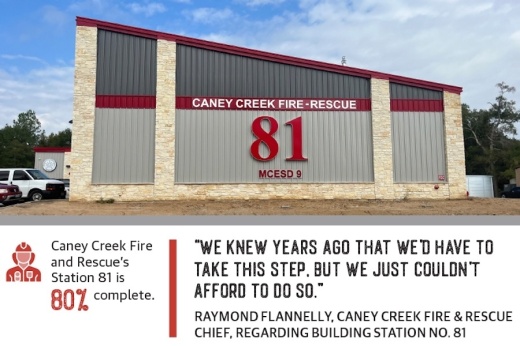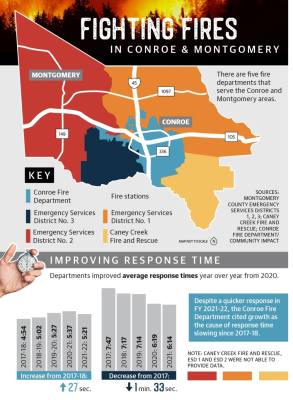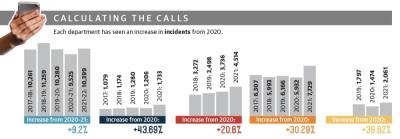Each department said the main struggle is staffing. Mike Legoudes Jr., assistant fire chief for the Conroe Fire Department, said in an interview the problem is not only having applicants, but also finding qualified applicants.
"Like everybody else in the state, we are not getting as many applicants as we would like,” Legoudes said. “At the last exam we had, we had about 31 people show up, and we were able to hire four of them. So that’s the challenge is finding enough qualified candidates.”
Further, departments said supply chain issues are becoming prevalent. According to Leonard Mikeska, chief of Montgomery County Emergency Services District No. 3, it takes two years to receive a fire truck, but in the past, a fire truck could be delivered within months of ordering.
“We can’t even get parts for trucks,” ESD 3 President Greg Holcombe said. “When they break down, we are scrambling around.”
Growing demand
There are three major Montgomery County ESDs that provide firefighting services for the Conroe and Montgomery area with the help of Caney Creek Fire and Rescue and the Conroe Fire Department.
ESD 1 serves 200 square miles within the north county area, including Willis. ESD 2 serves as Montgomery’s major fire department serving the west shoreline of Lake Conroe and neighborhoods including Walden, Grand Harbor and Bentwater. ESD 3 serves the Honea Egypt area.
Caney Creek Fire and Rescue partners with ESD 9, while Conroe Fire Department is a city service and does not serve under an ESD.
Across all departments there is a trend of increased calls and decreased response times, data shows.
According to CFD data, incidents in fiscal year 2021-22 increased over the last fiscal year by 874 incidents. The number of incidents peaked in FY 2018-19 with 11,259 reported incidents, but after dropping earlier in the pandemic, incidents have risen the last two years.
Response times have fluctuated as well the last five years. After slowing by 35 seconds from 2018-19 to 2020-21, the average response time improved by 16 seconds over the last year.
Legoudes cited a rising population for increased incidents and response times.
ESD 3 also reported a rise in incidents in 2021. Reported incidents peaked in 2021 at 1,733 calls, according to the district. This is 726 more incidents reported than in 2022 calendar year to date. However, the department has seen its average response time improve by 1 minute and 33 seconds over the past five years.
ESD 3 Assistant Fire Chief Keith Soliz cited rapid growth in the district with around 600 residential homes and 40 new businesses added annually over the last five years.
ESD 1 Fire Chief Jason Oliphant said there is a similar growth pattern with an estimated 25 subdivisions being built within the district. ESD 1 also reports new commercial growth, such as a new H-E-B in Willis.
Oliphant said growth leads to a higher call volume and the need to hire more firefighters.
“Growth in population means volume growth also, which also means more expenses to respond to those calls,” Oliphant said.
New facilities coming
Each department has different capital improvement projects looking to be completed within the next five years.
For example, ESD 1 is working to build a new logistics maintenance facility, a new training complex and two additional stations—one on FM 1097 East and the other on Calvary Road—Oliphant said.
Due to rapid growth, he said department officials believed there was a need to have their own facility to cut back on travel time to other training facilities. The maintenance facility and training complex will cost a combined $8.3 million with funds coming from property tax revenue. The fire station costs have yet to be projected.
According to ESD 2 Chief Brian Edwards, a new station totaling around $3 million located in Walden is projected to be completed in spring 2023. Edwards also said within the next five years he hopes to add a station to the northwest and southwest areas of the district.
Meanwhile, Caney Creek Fire and Rescue announced the opening of Station No. 81 at 16723 FM 2090 on Aug. 19. Chief Raymond Flannelly said the station is approximately 80% finished with completion expected for mid-December. He said the building has been used for 30 years and has flooded over three times with firefighters staying in a trailer house behind the station for the last three years.
As such, Flannelly said the need for a new station has been prevalent, but the department has had trouble prioritizing its $8.3 million construction due to insufficient funds.
“We knew years ago we needed to take this step; we just couldn’t afford to do so,” Flannelly said.
Other projects across the Conroe and Montgomery areas include the CFD’s eighth station, which was approved during the adoption of the city’s FY 2022-23 capital improvement projects budget. The budgeted $5.5 million station is projected to break ground by the first quarter of 2023 and finish in early 2024, Legoudes said.
According to Legoudes, a new fire station for the CFD will allow the department to better serve the southeast side of Conroe. Currently, Station No. 2 and Station No. 3 are serving the FM 3083 and Presswood Drive area, but having a new station in this area will improve response times.
Staffing, station needs
With the exception of CFD, all fire departments reported staffing problems. Mikeska said there are more firefighter jobs than there are firefighters to fill the positions.
“Most of the fire departments in this whole area, including Harris County, they are relying more on paid firefighters instead of volunteers due to call volume and the growth,” Mikeska said.
Oliphant confirmed a staffing shortage within his district as well. To combat the staffing shortage, he said the department will begin hosting its own fire and EMT academy in December.
“We are going to hire them as an employee, and they are going to get paid while they go through the academy at a reduced rate. After about six months, they will move to the floor and become our normal staffing,” Oliphant said.
In addition to staffing shortages, Flannelly said cost and delivery problems are growing for Caney Creek, especially with parts and fire trucks. He said the department bought two engines in 2011 for roughly $333,000 each, but he estimates it would cost $650,000 for a fire truck today. He said the station will need two additional engines over the next two years.
“If I ordered a fire truck today, it wouldn’t be delivered until two years from now,” Flannelly said. “Typically when you [purchase] a truck out, six months later, it’s in your station.”









